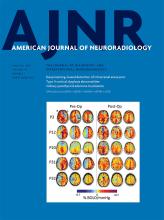Index by author
Cho, S.H.
- NeurointerventionOpen AccessOsseous versus Nonosseous Spinal Epidural Arteriovenous Fistulas: Experiences of 13 PatientsY. Song, S.H. Cho, D.W. Lee, J.J. Sheen, J.H. Shin and D.C. SuhAmerican Journal of Neuroradiology January 2019, 40 (1) 129-134; DOI: https://doi.org/10.3174/ajnr.A5904
Cho, Y.J.
- Pediatric NeuroimagingOpen AccessMR Imaging–Based Radiomic Signatures of Distinct Molecular Subgroups of MedulloblastomaM. Iv, M. Zhou, K. Shpanskaya, S. Perreault, Z. Wang, E. Tranvinh, B. Lanzman, S. Vajapeyam, N.A. Vitanza, P.G. Fisher, Y.J. Cho, S. Laughlin, V. Ramaswamy, M.D. Taylor, S.H. Cheshier, G.A. Grant, T. Young Poussaint, O. Gevaert and K.W. YeomAmerican Journal of Neuroradiology January 2019, 40 (1) 154-161; DOI: https://doi.org/10.3174/ajnr.A5899
Choi, B.H.
- Adult BrainYou have accessClinical Feasibility of Zero TE Skull MRI in Patients with Head Trauma in Comparison with CT: A Single-Center StudyS.B. Cho, H.J. Baek, K.H. Ryu, B.H. Choi, J.I. Moon, T.B. Kim, S.K. Kim, H. Park and M.J. HwangAmerican Journal of Neuroradiology January 2019, 40 (1) 109-115; DOI: https://doi.org/10.3174/ajnr.A5916
Chuang, H.H.
- Head and Neck ImagingYou have accessSolitary Parathyroid Adenoma Localization in Technetium Tc99m Sestamibi SPECT and Multiphase Multidetector 4D CTT.H. Vu, D. Schellingerhout, N. Guha-Thakurta, J. Sun, W. Wei, S.C. Kappadth, N. Perrier, E.E. Kim, E. Rohren, H.H. Chuang and F.C. WongAmerican Journal of Neuroradiology January 2019, 40 (1) 142-149; DOI: https://doi.org/10.3174/ajnr.A5901
Chung, K.
- FELLOWS' JOURNAL CLUBAdult BrainOpen AccessRadiomics-Based Intracranial Thrombus Features on CT and CTA Predict Recanalization with Intravenous Alteplase in Patients with Acute Ischemic StrokeW. Qiu, H. Kuang, J. Nair, Z. Assis, M. Najm, C. McDougall, B. McDougall, K. Chung, A.T. Wilson, M. Goyal, M.D. Hill, A.M. Demchuk and B.K. MenonAmerican Journal of Neuroradiology January 2019, 40 (1) 39-44; DOI: https://doi.org/10.3174/ajnr.A5918
Sixty-seven patients with ICA/M1 MCA segment thrombus treated with IV alteplase were included in this analysis. Three hundred twenty-six radiomics features were extracted from each thrombus on both NCCT and CTA images. Linear discriminative analysis was applied to select features most strongly associated with early recanalization with IV alteplase. These features were then used to train a linear support vector machine classifier. Thrombus radiomics features derived from NCCT and CTA are more predictive of recanalization with IV alteplase in patients with acute ischemic stroke with proximal occlusion than previously known thrombus imaging features such as length, volume, and permeability.
Cocozza, S.
- EDITOR'S CHOICEAdult BrainOpen AccessDeterminants of Deep Gray Matter Atrophy in Multiple Sclerosis: A Multimodal MRI StudyG. Pontillo, S. Cocozza, R. Lanzillo, C. Russo, M.D. Stasi, C. Paolella, E.A. Vola, C. Criscuolo, P. Borrelli, G. Palma, E. Tedeschi, V.B. Morra, A. Elefante and A. BrunettiAmerican Journal of Neuroradiology January 2019, 40 (1) 99-106; DOI: https://doi.org/10.3174/ajnr.A5915
Seventy-seven patients with MS and 44 healthy controls were enrolled in this cross-sectional study. MR imaging investigation included volumetric, diffusion tensor imaging, perfusion weighted imaging, and Quantitative Susceptibility Mapping analyses. Deep gray matter structures were automatically segmented to obtain volumes and mean values for each MR imaging metric in the thalamus, caudate, putamen, and globus pallidus. Patients with MS showed a multifaceted involvement of the thalamus and basal ganglia, with significant atrophy of all deep gray matter structures. In the relapsing-remitting MS group, WM lesion burden proved to be the main contributor to volume loss for all deep gray matter structures.
Corey, A.S.
- Head and Neck ImagingOpen AccessImaging of Surgical Free Flaps in Head and Neck ReconstructionJ.L. McCarty, A.S. Corey, M.W. El-Deiry, H.M. Baddour, B.M. Cavazuti and P.A. HudginsAmerican Journal of Neuroradiology January 2019, 40 (1) 5-13; DOI: https://doi.org/10.3174/ajnr.A5776
Crawley, A.
- EDITOR'S CHOICEAdult BrainYou have accessImproved White Matter Cerebrovascular Reactivity after Revascularization in Patients with Steno-Occlusive DiseaseL. McKetton, L. Venkatraghavan, C. Rosen, D.M. Mandell, K. Sam, O. Sobczyk, J. Poublanc, E. Gray, A. Crawley, J. Duffin, J.A. Fisher and D.J. MikulisAmerican Journal of Neuroradiology January 2019, 40 (1) 45-50; DOI: https://doi.org/10.3174/ajnr.A5912
Thirty-five patients with steno-occlusive disease (Moyamoya disease [n = 24], Moyamoya syndrome [n = 3], atherosclerosis [n = 6], vasculitis [n = 1], and idiopathic stenosis [n = 1]) who underwent unilateral brain revascularization using a direct superficial temporal artery–to-MCA bypass were evaluated. WM cerebrovascular reactivity was measured preoperatively and postoperatively using BOLD MR imaging during iso-oxic hypercapnic changes in end-tidal carbon dioxide. WM cerebrovascular reactivity significantly improved after direct unilateral superficial temporal artery–to-MCA bypass in the revascularized hemisphere in the MCA territory and in the anterior cerebral artery territory.
Criscuolo, C.
- EDITOR'S CHOICEAdult BrainOpen AccessDeterminants of Deep Gray Matter Atrophy in Multiple Sclerosis: A Multimodal MRI StudyG. Pontillo, S. Cocozza, R. Lanzillo, C. Russo, M.D. Stasi, C. Paolella, E.A. Vola, C. Criscuolo, P. Borrelli, G. Palma, E. Tedeschi, V.B. Morra, A. Elefante and A. BrunettiAmerican Journal of Neuroradiology January 2019, 40 (1) 99-106; DOI: https://doi.org/10.3174/ajnr.A5915
Seventy-seven patients with MS and 44 healthy controls were enrolled in this cross-sectional study. MR imaging investigation included volumetric, diffusion tensor imaging, perfusion weighted imaging, and Quantitative Susceptibility Mapping analyses. Deep gray matter structures were automatically segmented to obtain volumes and mean values for each MR imaging metric in the thalamus, caudate, putamen, and globus pallidus. Patients with MS showed a multifaceted involvement of the thalamus and basal ganglia, with significant atrophy of all deep gray matter structures. In the relapsing-remitting MS group, WM lesion burden proved to be the main contributor to volume loss for all deep gray matter structures.
Cross, N.M.
- Adult BrainYou have accessCompressed Sensing–Sensitivity Encoding (CS-SENSE) Accelerated Brain Imaging: Reduced Scan Time without Reduced Image QualityJ.E. Vranic, N.M. Cross, Y. Wang, D.S. Hippe, E. de Weerdt and M. Mossa-BashaAmerican Journal of Neuroradiology January 2019, 40 (1) 92-98; DOI: https://doi.org/10.3174/ajnr.A5905








